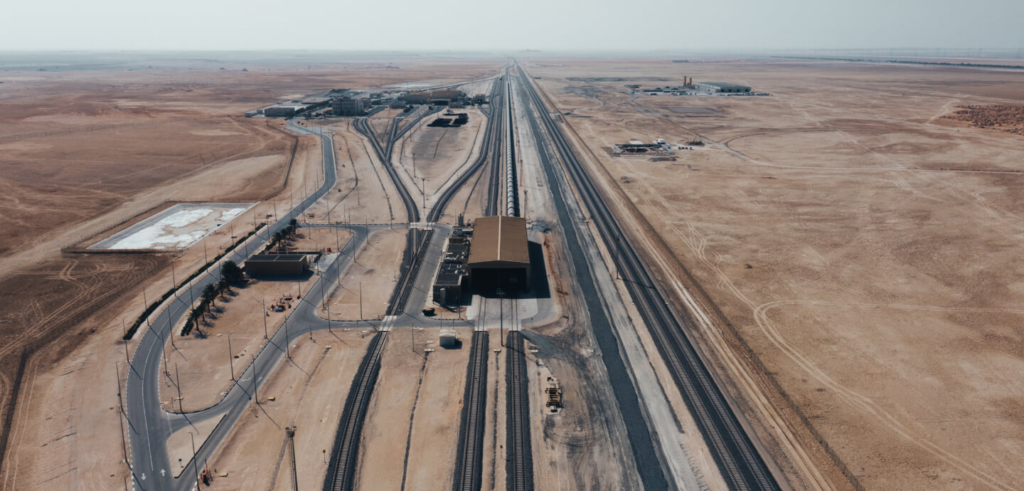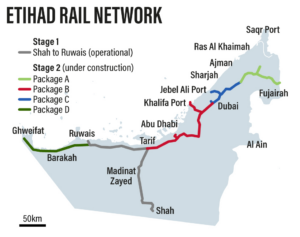In the United Arab Emirates (UAE), a 1,200 km railway infrastructure project called Tihad Rail is being constructed. The railway line crosses the United Arab Emirates and ends in Fujairah, which is located on the Indian Ocean coast, at the Saudi border. An estimated AED 40 billion ($11 billion) is being invested in its development.
In June 2009, Etihad Rail (formerly known as Union Railway Company) was founded with the goal of creating, constructing, and running the railway infrastructure. The federal government of the United Arab Emirates (30%) and the government of Abu Dhabi (70%), jointly own it.
A crucial component of the $100 billion Gulf Cooperation Council (GCC) rail project will be the railway infrastructure. By 2024, the GCC railway network—which will link the UAE with Saudi Arabia, Qatar, Kuwait, Bahrain, and Oman—should be completed. The seven emirates of the United Arab Emirates are connected by roads, and the country has a well-developed ground road transit network.

It is anticipated that the new railway project will provide a cost-effective and environmentally friendly option for moving people and goods throughout the Emirate’s rural and urban areas. About 16 million people and 50 million tonnes of freight are anticipated to be served by it.
The infrastructure of the railroads will play a major role in lowering emissions from motor vehicles. Trade and social development inside the Emirate and among the GCC nations will be aided by railway connectivity.
There are two phases to the Etihad Rail construction: Stage One and Stage Two. Phase One was finished in 2016 and Phase Two is still being built. Over 70% of the railway network’s Stage Two has been finished with construction.
Construction of the main transportation infrastructure
The 264 km western section of the railway network, connecting Shah and Al Ruwais, is known as Stage One. It ties Habshan and Shah together as well as Ruwais and Habshan.In cooperation with the Abu Dhabi National Oil Company (ADNOC), the Shah-Habshan-Ruwais goods line was constructed. From Habshan and Shah to Al Ruwais in Abu Dhabi, it ships over seven million tonnes of granulated sulphur annually for export.
Building bridges, creating a railway depot at Mirfa, and developing communication systems were all part of Stage One of the railway network. By strategically aligning mainline civil and track packages geographically within each emirate, the construction of Stage Two is being done in a series of packages with the goal of ensuring competitive bidding.
Package A links Ghuwaifat with Stage One over a distance of 139 kilometres. The completion date was September 2021. Ongoing construction is taking place on the remaining packages. Package B spans 216 km and links Tarif and Saih Shuaib, while Package C connects Jebel Ali and Sharjah over 94 km. The last package, Package D, travels 145 kilometres between Sharjah and Dubai. Package D consists of nine tunnels that were finished in November 2021.
To guarantee that the right contractors have submitted their preferred packages for the goods facilities and operations and maintenance (O&M), separate packaging was used. After a $13.62 billion ($AED 50 billion) investment, a 256 km straight line was finished in March 2022 between Abu Dhabi and Dubai. It involved building sixty crossings, 137 drainage ditches, and 29 bridges.
Route of the Etihad Rail network
The network of Etihad Rail extends westward to the boundaries of Saudi Arabia and Qatar. The eastern part connects Oman with Ghweifat, while the western section connects Saudi Arabia with Al Ain. The railway line that connects Dubai, Abu Dhabi, and Sharjah crosses the Emirate.
After that, it reaches Fujairah and the northern emirates. The UAE railway will establish connections with ports, industrial zones, raw material suppliers, and important population centres.
On the east coast of the United Arab Emirates, Stage Two of the railway line stretches 605 km from the Saudi Arabian border at Ghuweifat to connect the Emirates via Abu Dhabi, Khalifa Port, Kizad, Dubai, Ras al-Khaimah, Jebel Ali Port, Sharjah, and Fujairah.Through the network’s passenger services, 11 cities and sites will be connected inside the United Arab Emirates. Abu Dhabi and Dubai will take 50 minutes to reach, Fujairah and Abu Dhabi will take 100 minutes, Dubai and Fujairah will take 50 minutes, and Abu Dhabi and Al Ruwais will take 70 minutes. By 2030, it is anticipated that there will be more than 36.5 million passengers yearly.

Communications and signalling on the UAE Etihad Rail network
Etihad Rail and communications expert Du signed an MOU in June 2011 to construct the integrated telecoms infrastructure for the train project.
Du offered consultation and technical support. An agreement was made in April 2011 between Etihad Rail and Etisalat to create cutting-edge infrastructure and telecommunications systems for the safe and effective operation of the train network.
Financing
In order to expand passenger transport services on the railway network, Etihad Rail and First Abu Dhabi Bank inked a financing arrangement for AED1.99 billion ($541.7 million) in February 2022. The arrangement is a component of the largest land rail network of its sort in the United Arab Emirates, the UAE National Railways Programme.
Rolling stock
The SD70ACS electro-motive diesel locomotives and waggons are among the heavy transport locomotives and multipurpose waggons operated by Etihad Rail.
The European Train Control System (ETCS) Level 2 signalling system is fitted on the SD70 locomotives. A locomotive may tow five thousand tonnes (t) or one hundred wagons. The locomotives are built to last the geographic and climatic conditions of the GCC region while maintaining excellent performance and efficiency. They also have sophisticated cooling systems.
With a length of 22.63 metres, the locomotives can reach top speeds of 120 km/h. They weigh 193 tonnes and are constructed from welded steel structures. A variety of commodities, including rocks, cement, iron, hydrocarbons, and aluminium, are transported by heavy freight trains.
Hopper waggons, flat waggons, single well container waggons, and five-car well container waggons are among the different kinds of waggons used on railway projects. Every kind of waggon has a different carrying capacity. Advanced braking, signalling, control, communication, and safety systems are fitted to the wagons.
On the passenger route, push-pull trains will be run by Etihad Rail. With a 400-passenger capacity per train, the passenger trains will run at 200 km/h.
FAQs
Where does the Etihad Rail network go?
The Etihad Rail network stretches across the United Arab Emirates, connecting all seven emirates. It runs from the western border with Saudi Arabia at Ghweifat to the eastern coast at Fujairah.
Is the Etihad Rail network operational?
Yes, the Etihad Rail network is operational for freight trains. Passenger services are still under development, but a successful trial run took place in January 2024.
What are the future plans for the Etihad Rail network?
The long-term goal is for the Etihad Rail network to connect the UAE to neighbouring GCC countries, including Saudi Arabia and Oman.
How long is the Etihad Rail network?
The current operational network is around 900 kilometres long. Once fully complete, it is expected to reach approximately 1,200 kilometres.
What are the benefits of the Etihad Rail network?
The Etihad Rail network offers several advantages, including reduced travel times, more affordable transportation, improved safety and reliability, and a more environmentally friendly mode of transport.

